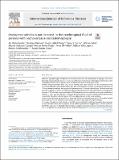Onchocerca Volvulus is not Detected in the Cerebrospinal Fluid of Persons with Onchocerciasis-associated Epilepsy
View/
Publication Date
2019-12Type
Article, Journalviews
downloads
Metadata
Show full item recordCitation
Hotterbeekx, A., Raimon, S., Abd-Elfarag, G., Carter, J. Y., Sebit, W., Suliman, A., Siewe Fodjo, J. N., De Witte, P., Logora, M. Y., Colebunders, R., & Kumar-Singh, S. (2020). Onchocerca volvulus is not detected in the cerebrospinal fluid of persons with onchocerciasis-associated epilepsy. International journal of infectious diseases : IJID : official publication of the International Society for Infectious Diseases, 91, 119–123. https://doi.org/10.1016/j.ijid.2019.11.029
Abstract/
Objectives: Epidemiological evidence links onchocerciasis with the development of epilepsy. The aim of this study was to detect Onchocerca volvulus microfilariae or its bacterial endosymbiont, Wolbachia, in the cerebrospinal fluid (CSF) of persons with onchocerciasis-associated epilepsy (OAE). Methods: Thirteen persons with OAE and O. volvulus skin snip densities of >80 microfilariae were recruited in Maridi County (South Sudan) and their CSF obtained. Cytospin centrifuged preparations of CSF were examined by light microscopy for the presence of O. volvulus microfilariae. DNA was extracted from CSF to detect O. volvulus (O-150 repeat) by quantitative real-time PCR, and Wolbachia (FtsZ gene) by standard PCR. To further investigate whether CSF from onchocerciasis-infected participants could induce seizures, 3- and 7-day old zebrafish larvae were injected with the CSF intracardially and intraperitoneally, respectively. For other zebrafish larvae, CSF was added directly to the larval medium. Results: No microfilariae, parasite DNA, or Wolbachia DNA were detected in any of the CSF samples by light microscopy or PCR. All zebrafish survived the procedures and none developed seizures. Conclusions: The absence of O. volvulus in the CSF suggests that OAE is likely not caused by direct parasite invasion into the central nervous system, but by another phenomenon triggered by O. volvulus infection.
Subject/
Autoimmunity; Disabilities; Microfilariae; Nodding syndrome; Onchocerciasis-associated epilepsy; Seizures; South Sudan
Further Details
© 2019 The Author(s). Published by Elsevier Ltd on behalf of International Society for Infectious Diseases. This is an open access article under the CC BY-NC-ND license (http://creativecommons.org/licenses/by-nc-nd/4.0/).
Publisher
ElsevierCollections
- General - GEN [367]

